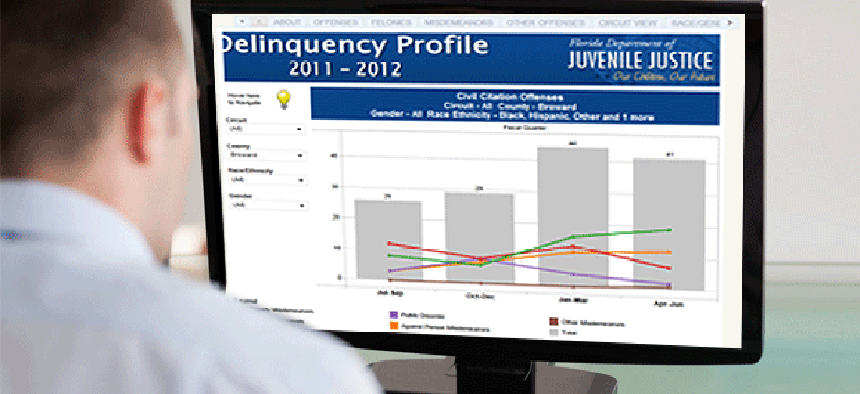Visual analytics help Florida tell the story of juvenile justice reform

The state's Department of Juvenile Justice uses Tableau Software for an interactive view of juvenile programs that can be filtered from the statewide to county level.
The Florida Department of Juvenile Justice is using visual analytics to present a clearer picture of children in the justice system and the effectiveness of the state’s innovative reform efforts.
The state’s Juvenile Justice Information System is one of the largest juvenile databases in the country, generating millions of lines of data about juvenile arrests, recidivism and reform outcomes.
To provide this information to stakeholders, DJJ had published annual, lengthy reports or posted Microsoft Excel files online. But department officials could not correct errors or add information to the reports once they were published, said DJJ data analyst Mark Russell, prompting the search for an interactive presentation tool that was both easy to update and learn.
Additionally, the department wanted a tool to help tell its juvenile justice reform story with data visualizations that would illustrate how giving a “civil citatation” to first offenders had reduced recidivism in areas where it was actively encouraged.
During a search for data presentation software, a member of Russell’s team came across Tableau Software, a self-service business intelligence tool that lets people of any skill level create data visualizations. Tableau Desktop lets users connect to data of any size or format on the fly. Databases, spreadsheets and big data sources can be combined into visualizations, reports or dashboards, according to company officials.
DJJ uses Tableau to generate interactive data presentations for its Internet and intranet sites. The software lets users examine crime and youth needs from a statewide big picture down to the local county view with a change of a filter, Russell said during an interview at the Tableau Software Customer Conference held in National Harbor, Md.
Tableau gives officials from Florida’s 67 counties access to information that they previously had to request from DJJ. For instance, the new online version of the state’s 2011-2012 Delinquency Profiles report shows a bar chart of the number of juvenile arrests statewide between 2007-2012. Using drop-down filters, officials can generate charts in real time with specific details, such as county, ethnicity, type of crime or status in the justice system, Russell said. They can also use the Web-based tool to visualize how different practices and procedures across the state can affect outcomes.
That capability helped officials measure the effectiveness of reform efforts such as the Civil Citation program, where children arrested for first-time misdemeanors such as writing graffiti or shoplifting can avoid an arrest record by going through an early intervention program.
Broward County in the Ft. Lauderdale area adopted the civil citation program a year ago. Of the 90 first-time offenders recorded in the county, 51 received civil citations. DJJ has been issuing civil citations for two years, which offers an opportunity to look at the re-offense rate of children who received the citations in the first 12 months of the program and again 12 months later. “We are able to measure how well law enforcement is doing in implementing this reform strategy,” Russell said. “Tableau is great at showing the big picture.”
Children who received civil citations had a 6.8 percent re-offense rate, faring better than those who participated in other programs to divert them from the court system. That group had a 12 percent re-offense rate. “So, civil citation is almost twice as effective at getting children not to offend again,” Russell said. In fact, children with civil citations almost did better than those who did not commit a crime, according to Russell. Armed with this data, DJJ can measure “our success in convincing police officers to use the program,” he said.





